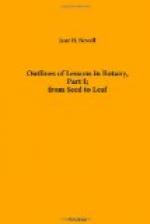1. Forms and Structure.—Provide the pupils with a number of green leaves, illustrating simple and compound, pinnate and palmate, sessile and petioled leaves. They must first decide the question, What are the parts of a leaf? All the specimens have a green blade which, in ordinary speech, we call the leaf. Some have a stalk, or petiole, others are joined directly to the stem. In some of them, as a rose-leaf, for instance, there are two appendages at the base of the petiole, called stipules. These three parts are all that any leaf has, and a leaf that has them all is complete.
Let us examine the blade. Those leaves which have the blade in one piece are called simple; those with the blade in separate pieces are compound. We have already answered the question, What constitutes a single leaf?[1] Let the pupils repeat the experiment of cutting off the top of a seedling Pea, if it is not already clear in their minds, and find buds in the leaf-axils of other plants.[2]
[Footnote 1: See page 31.]
[Footnote 2: With one class of children, I had much difficulty in making them understand the difference between simple and compound leaves. I did not tell them that the way to tell a single leaf was to look for buds in the axils, but incautiously drew their attention to the stipules at the base of a rose leaf as a means of knowing that the whole was one. Soon after, they had a locust leaf to describe; and, immediately, with the acuteness that children are apt to develop so inconveniently to their teacher, they triumphantly refuted my statement that it was one leaf, by pointing to the stiples. There was no getting over the difficulty; and although I afterwards explained to them about the position of the buds, and showed them examples, they clung with true childlike tenacity to their first impression and always insisted that they could not see why each leaflet was not a separate leaf.]
An excellent way to show the nature of compound leaves is to mount a series showing every gradation of cutting, from a simple, serrate leaf to a compound one (Figs. 24 and 25). A teacher, who would prepare in summer such illustrations as these, would find them of great use in his winter lessons. The actual objects make an impression that the cuts in the book cannot give.
[Illustration: FIG. 24.—Series of palmately-veined leaves.]
[Illustration: FIG. 25.—Series of pinnately-veined leaves.]
Let the pupils compare the distribution of the veins in their specimens. They have already distinguished parallel-veined from netted-veined leaves, and learned that this difference is a secondary distinction between monocotyledons and dicotyledons.[1] The veins in netted-veined leaves are arranged in two ways. The veins start from either side of a single midrib (feather-veined or pinnately-veined), or they branch from a number of ribs which all start from the top of the petiole, like the fingers from the palm of the hand (palmately-veined). The compound leaves correspond to these modes of venation; they are either pinnately or palmately compound.




